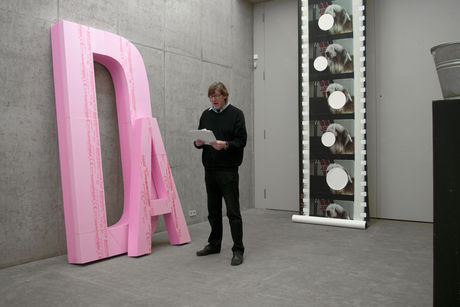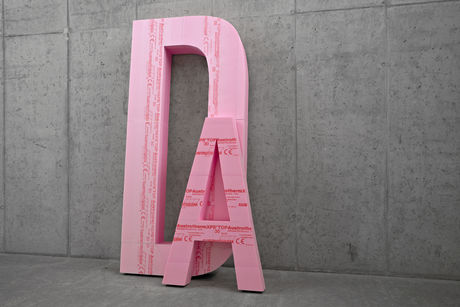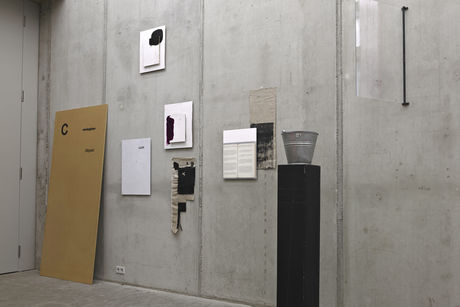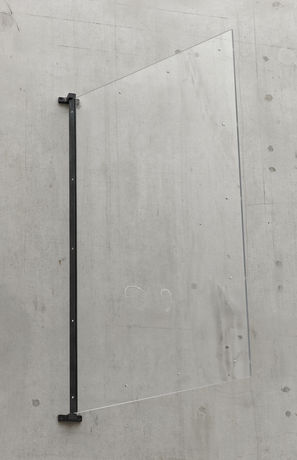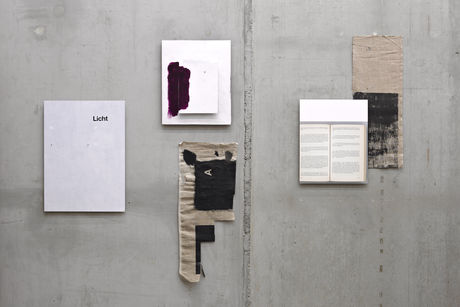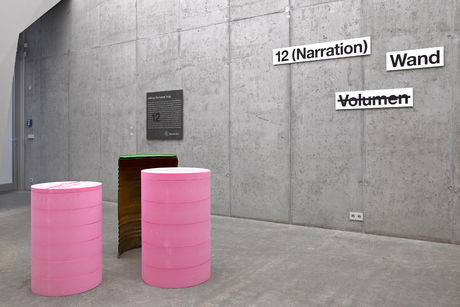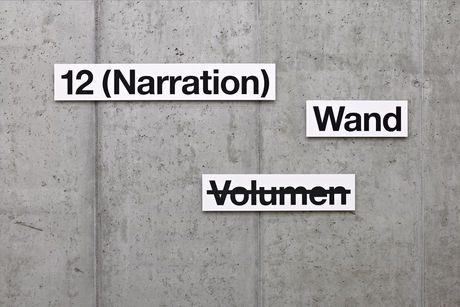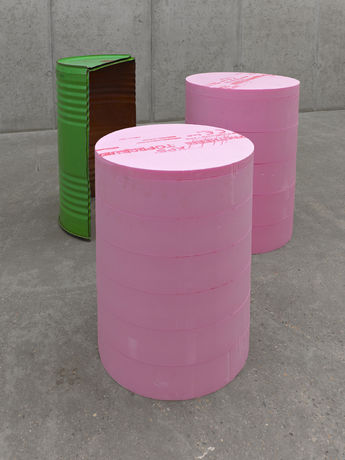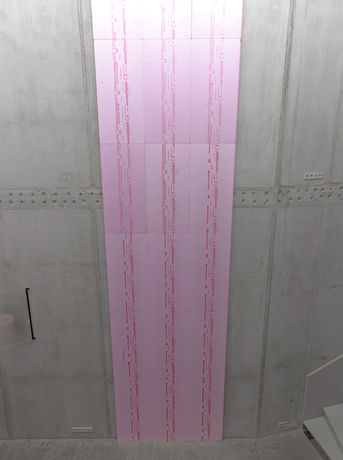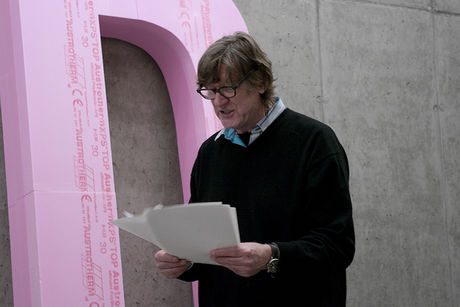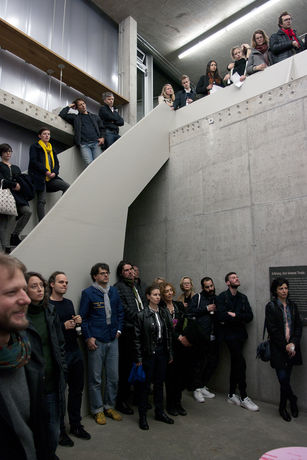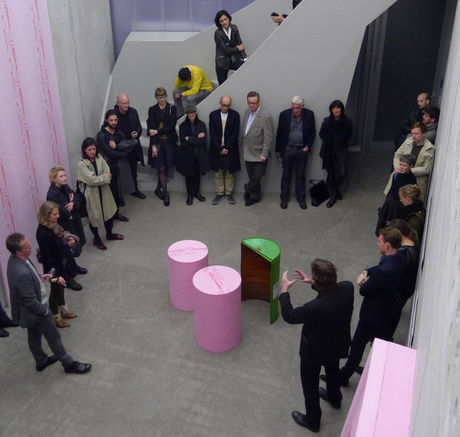Heinrich Dunst
Dämmstoffe
Nov 1–Dec 18, 2014
“From my mouth!” he says and sticks out his tongue. “Da!”—“there!” We look at him quizzically. “There!!” What’s he pointing at? “From my mouth!!” At the pinkish, speaking muscle there? “The words! There!!” At language itself? Or does he mean the two voluminous giant polystyrene letters, a D and an A, casually set against the wall a few yards away (they, too, are pinkish, like a laconic echo)? By the way: “he” is the Vienna-based artist Heinrich Dunst, now in Berlin for his first solo exhibition in Germany, at KOW. His verbal demonstration brings us straight to the issues his art explores. This “Da!” is difficult to grasp. It simultaneously points to itself and at something else. It is both word and sound, both statement and sign, both the tongue that speaks and two letters made out of insulation material. Like a particle in quantum mechanics, it occupies all of these states at the same time.
It shares this elusiveness with a dozen linguistic and pictorial objects, sculptures, and paintings on view throughout the gallery’s ground-floor space. The attempt to once and for all sort out the function and significance of any part of this installation is bound to fail. Inconclusive work forms are engaged in conversation with each other like fragments at a loss for a whole. Each component is a torso, its unguarded flanks open to passes – analogies with, and differences from, other components – but no goal is ever scored. The intellectual and physical void between objects teems with threads of discussions that fray only moments later. Dunst disappoints our expectation that things should make sense. It’s not that they get up to nonsense; but confronted with our longing for insight, they dispatch us, round after round, into a tangle of decoys the mind never quite catches hold of.
What’s going on here? Have we lost our way? Not at all. Believing that durable bridges can be built between world and mind means you’ve been out of it for a long while. Same if you still think there’s a need to take such bridges down. Dunst has instead set up a semiotic example that illustrates how bumping against knowledge’s ostensible limits doesn’t mean failure, but makes us smarter. His oeuvre, which dates back to the 1980s, has recently garnered renewed attention, and critics have highlighted how Dunst reveals the function of representation by sabotaging it. Relying on simple means, he has conceived a model that demonstrates the divide between what can be seen and what can be said, and lets us consider both the object and the subject of aesthetic perception from a distance – an insulation, as it were, that puts advocates of hermeneutics in a tight spot.
But why does he do this? What are the consequences? And what does it have to do with us? The illustrations of reality disseminated primarily by the major media machines, but sometimes also by art, constantly suggest that images, propositions, and events exist in perfect unanimity, obfuscating the differences between them in a gooey ideological totalitarianism of signs that knows neither ambivalence nor contradiction. Hence the tenacious illusion of a well-performing social body; hence the imposition on it of unequivocal political, economic, and social properties that aren’t and couldn’t possibly be real. Dunst calls out the violence implicit in this compulsion. By insisting on dissent and divergence, he seeks to ward off the integration of the real into the molds of closed identities.
That’s why Dunst’s works are little difference machines. Perusing his installation, our mind stutters, confronted with paradoxical events. Perception slips into the cracks between two phenomena and traverses their various layers, witnessing the transformation of images into words, words into sculpture, sculpture into film and back again. Media become trampolines that ideas use to leapfrog from one guise to the next, turning into something else in the act. Material and proportion, color and sign, space and concept: in the dialogue between them, each reveals its individual relevance as its intellectual function shifts along a fractal structure of ever-new analogies and discontinuities. The things right before our noses multiply in time and continually take on new meanings.
In the transition from one difference to the next, Dunst effectively transmutes space into time. The narrative sequences within his installation, inevitably nonlinear and replete with cross-associations, are akin to both filmmaking and the Internet. Dunst activates and radicalizes consecutiveness as the only form that allows us to see something several times and differently each time. His things undergo rapid and profound metamorphoses in so many directions at once that our opinions of them can hardly keep up. The artist subverts our desire for certainty and instead hones our awareness of the speculative and possible. Faced with his work, we devise new criteria at every moment to make sense of what we see; to align it with our poetics of the real. An accomplished conceptual painter as well as Concrete poet, Dunst refuses to let this process reach a conclusion and instead allows us to study its manifold twists and turns.
Where does that leave the subject-object correspondence? Are representations mere arrows we shoot at the world, hoping they suspend it? What they strike, in any case, is our imagination. Dunst’s models reveal how adeptly we forge meaning out of the fact that things are no more at one with us than they are with themselves. His art is an exercise program designed to gauge the interminability of any object or event, any sign or future potential. His work thus has much in common with anti-essentialist and anti-representational positions in art and philosophy that KOW has highlighted on several occasions. Their shared ultimate point is this: the highest order to which we can delegate responsibility for our reality is our imagination.
Text: Alexander Koch
Translation: Gerrit Jackson
Editing: Kimberly Bradley
Photos: Ladislav Zajac, KOW
It shares this elusiveness with a dozen linguistic and pictorial objects, sculptures, and paintings on view throughout the gallery’s ground-floor space. The attempt to once and for all sort out the function and significance of any part of this installation is bound to fail. Inconclusive work forms are engaged in conversation with each other like fragments at a loss for a whole. Each component is a torso, its unguarded flanks open to passes – analogies with, and differences from, other components – but no goal is ever scored. The intellectual and physical void between objects teems with threads of discussions that fray only moments later. Dunst disappoints our expectation that things should make sense. It’s not that they get up to nonsense; but confronted with our longing for insight, they dispatch us, round after round, into a tangle of decoys the mind never quite catches hold of.
What’s going on here? Have we lost our way? Not at all. Believing that durable bridges can be built between world and mind means you’ve been out of it for a long while. Same if you still think there’s a need to take such bridges down. Dunst has instead set up a semiotic example that illustrates how bumping against knowledge’s ostensible limits doesn’t mean failure, but makes us smarter. His oeuvre, which dates back to the 1980s, has recently garnered renewed attention, and critics have highlighted how Dunst reveals the function of representation by sabotaging it. Relying on simple means, he has conceived a model that demonstrates the divide between what can be seen and what can be said, and lets us consider both the object and the subject of aesthetic perception from a distance – an insulation, as it were, that puts advocates of hermeneutics in a tight spot.
But why does he do this? What are the consequences? And what does it have to do with us? The illustrations of reality disseminated primarily by the major media machines, but sometimes also by art, constantly suggest that images, propositions, and events exist in perfect unanimity, obfuscating the differences between them in a gooey ideological totalitarianism of signs that knows neither ambivalence nor contradiction. Hence the tenacious illusion of a well-performing social body; hence the imposition on it of unequivocal political, economic, and social properties that aren’t and couldn’t possibly be real. Dunst calls out the violence implicit in this compulsion. By insisting on dissent and divergence, he seeks to ward off the integration of the real into the molds of closed identities.
That’s why Dunst’s works are little difference machines. Perusing his installation, our mind stutters, confronted with paradoxical events. Perception slips into the cracks between two phenomena and traverses their various layers, witnessing the transformation of images into words, words into sculpture, sculpture into film and back again. Media become trampolines that ideas use to leapfrog from one guise to the next, turning into something else in the act. Material and proportion, color and sign, space and concept: in the dialogue between them, each reveals its individual relevance as its intellectual function shifts along a fractal structure of ever-new analogies and discontinuities. The things right before our noses multiply in time and continually take on new meanings.
In the transition from one difference to the next, Dunst effectively transmutes space into time. The narrative sequences within his installation, inevitably nonlinear and replete with cross-associations, are akin to both filmmaking and the Internet. Dunst activates and radicalizes consecutiveness as the only form that allows us to see something several times and differently each time. His things undergo rapid and profound metamorphoses in so many directions at once that our opinions of them can hardly keep up. The artist subverts our desire for certainty and instead hones our awareness of the speculative and possible. Faced with his work, we devise new criteria at every moment to make sense of what we see; to align it with our poetics of the real. An accomplished conceptual painter as well as Concrete poet, Dunst refuses to let this process reach a conclusion and instead allows us to study its manifold twists and turns.
Where does that leave the subject-object correspondence? Are representations mere arrows we shoot at the world, hoping they suspend it? What they strike, in any case, is our imagination. Dunst’s models reveal how adeptly we forge meaning out of the fact that things are no more at one with us than they are with themselves. His art is an exercise program designed to gauge the interminability of any object or event, any sign or future potential. His work thus has much in common with anti-essentialist and anti-representational positions in art and philosophy that KOW has highlighted on several occasions. Their shared ultimate point is this: the highest order to which we can delegate responsibility for our reality is our imagination.
Text: Alexander Koch
Translation: Gerrit Jackson
Editing: Kimberly Bradley
Photos: Ladislav Zajac, KOW

